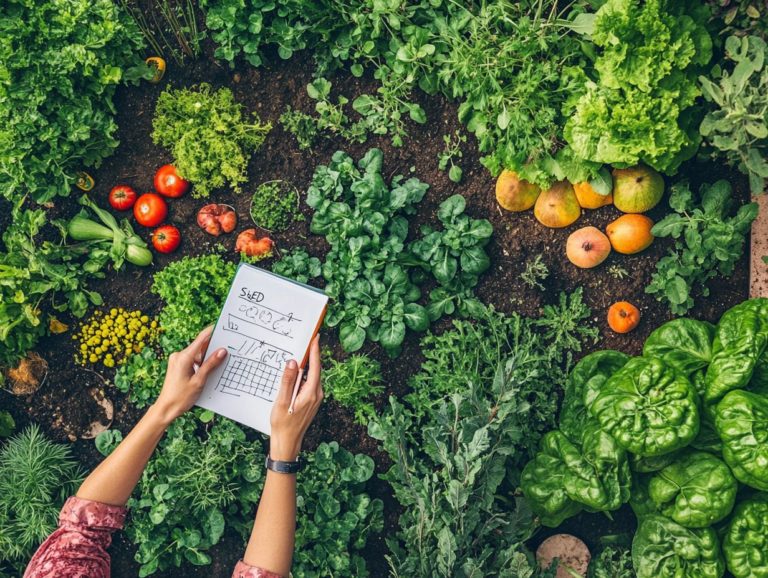Using Indigenous Plants in Permaculture Design
Incorporating indigenous plants into your permaculture design brings a myriad of benefits that extend far beyond mere aesthetics. These plants play a vital role in ecosystem preservation and sustainability, all while enhancing local adaptation and resilience.
Get ready to explore how to effectively identify and integrate indigenous species into your permaculture projects, complete with practical advice and examples of successful designs! It will also tackle common challenges you may encounter along the way, offering solutions to ensure your permaculture journey flourishes.
Whether you’re a seasoned gardener or just beginning your adventure, this exploration of indigenous plants will arm you with the knowledge you need to cultivate a thriving, sustainable ecosystem that exists in perfect harmony with nature.
Contents
- Local Adaptation and Resilience
- How to Incorporate Indigenous Plants into Permaculture Design
- Examples of Successful Permaculture Designs with Indigenous Plants
- Tackling Challenges with Native Plants
- Frequently Asked Questions
- What is permaculture design?
- Why should I use indigenous plants in permaculture design?
- How can I identify indigenous plants?
- What are the benefits of using indigenous plants in permaculture design?
- How do I incorporate indigenous plants into my permaculture design?
- Are there any precautions I should take when using indigenous plants in permaculture design?
Key Takeaways:

- Using indigenous plants in permaculture design promotes ecosystem preservation and sustainability.
- Incorporating indigenous plants into permaculture design allows for local adaptation and resilience.
- Identifying suitable plants and designing with indigenous plants are key steps in successful permaculture designs.
Understanding the Principles of Permaculture
Permaculture presents you with an innovative design system that seamlessly integrates ecological principles and sustainable practices to cultivate productive and diverse agricultural landscapes. By observing and mimicking the intricacies of natural ecosystems, you can enhance soil health and promote biodiversity.
Additionally, native plants create inviting wildlife habitats. This overall strategy prioritizes efficient nutrient cycling and underscores the significance of local ecosystems. It helps to forge resilient communities that thrive in harmony with nature.
In essence, the design strategies you employ within permaculture reflect nature’s remarkable efficiency. They lead to self-sustaining habitats that demand minimal external inputs.
By incorporating techniques such as terracing (leveling land to prevent soil erosion), swales (shallow channels designed to manage water runoff), and companion planting, you can optimize land use while reducing erosion and boosting water retention.
Utilizing native plants not only attracts local fauna but also significantly enriches soil fertility and structure. Together, these methods weave a vibrant tapestry of life, fostering healthy ecosystems that are more resistant to pests and diseases. Ultimately, they support sustainable gardening practices that anyone can embrace.
Benefits of Using Indigenous Plants in Permaculture Design
Incorporating indigenous plants into your permaculture design presents a multitude of advantages, such as:
- Enhanced biodiversity
- Improved soil fertility
- Creation of thriving wildlife habitats
These native species are inherently suited to local ecosystems, necessitating less maintenance and input while fostering ecological balance. By weaving them into your garden design, you can cultivate healthier plant communities that support sustainable practices and bolster the resilience of the environment.
Ecosystem Preservation and Sustainability
Ecosystem preservation is an essential pillar of sustainable practices, designed to uphold the balance and vitality of native ecosystems. By prioritizing biodiversity and employing ecological principles, permaculture design enables the restoration of wildlife habitats. This comprehensive approach benefits plant species and supports the diverse array of wildlife that relies on these ecosystems.
Start implementing these strategies today to make a difference in your garden:
- Companion planting fosters beneficial relationships between species, minimizing the need for chemical interventions while simultaneously boosting yields.
- Creating swales for water retention effectively manages water resources, mitigating the risk of flooding and promoting healthy soil ecosystems.
- Utilizing native plants enriches local biodiversity.
By integrating these techniques, you actively contribute to environmental health, cultivating a sustainable system that nourishes both flora and fauna. This ultimately ensures the longevity of these vital ecosystems.
Local Adaptation and Resilience

Local adaptation is essential for building resilience in permaculture systems. By integrating native plants that thrive in your specific regional conditions, you’ll inspire your community to care for the environment!
By focusing on environmentally friendly gardening methods that honor local ecosystems, you can contribute to restoring local habitats. This approach makes your farming practices productive and sustainable, promoting a variety of plants and animals and enhancing ecological health.
Incorporating native species not only benefits the environment but also strengthens community ties as you and your neighbors work together on restoration efforts. These plants are ideally suited to your local climate, needing fewer resources and less maintenance.
As you engage in these practices, you become more aware of your ecological impacts, deepening your commitment to caring for the land. This shared responsibility of nurturing local ecosystems fosters a sense of belonging and interconnectedness, both of which are vital for long-term sustainability.
This collective effort creates valuable learning experiences, enabling you to advocate for biodiversity while reinforcing the importance of preserving natural habitats for generations to come.
How to Incorporate Indigenous Plants into Permaculture Design
Incorporating indigenous plants into your permaculture design requires a deep understanding of their unique characteristics. Select species that enhance biodiversity and ecological balance.
These native plants not only champion sustainable gardening practices but also offer culinary and medicinal benefits. By thoughtfully integrating them into your garden, you can create flourishing ecosystems that support local wildlife while cultivating community awareness and appreciation for the environment.
Identifying and Selecting Suitable Plants
Identifying and selecting the right plants for your permaculture design is essential for nurturing biodiversity and advancing ecological gardening practices. By prioritizing native flora that harmonizes with local ecosystems, you’ll ensure that plant characteristics such as shade tolerance and moisture needs are met.
Begin your journey with thorough research on the specific conditions of your local environment, including soil types, climate, and existing wildlife. Understanding these elements allows you to make more informed choices about which indigenous plants will thrive in your space.
Recognizing the interrelationships among species will enable you to create symbiotic plant communities groups of plants that support each other s growth that enhance nutrient cycling and support pollinators. By weaving these considerations into your design, you not only bolster the resilience of the local ecosystem but also cultivate sustainable spaces that beautifully reflect the natural diversity of your surroundings.
Designing and Implementing with Indigenous Plants
Designing and implementing a permaculture system with indigenous plants requires a thoughtful approach that embraces ecological principles, plant communities, and the intricate guilds of plants groups of plants that work together for a common benefit.
By integrating native species into your garden design, you will cultivate a harmonious environment that supports diverse wildlife while enhancing the overall resilience of the ecosystem.
This approach goes beyond mere aesthetics; it fosters biodiversity and promotes soil health and water conservation essential components of sustainable land stewardship. Implementing strategies like companion planting allows you to create beneficial relationships among plants.
For example, by incorporating legumes, you can boost nitrogen levels in the soil, while flowering plants work to attract vital pollinators. Utilizing layers of vegetation, from ground covers to towering canopy trees, enables you to maximize both space and resources.
This results in a productive and self-sustaining system that beautifully reflects the natural ecology of your area.
Examples of Successful Permaculture Designs with Indigenous Plants

Successful permaculture designs that incorporate indigenous plants serve as exemplary models for how gardening that is good for the environment can significantly enhance biodiversity and promote sustainable practices.
These case studies showcase innovative methods for integrating native flora into a variety of agricultural systems. They illustrate the remarkable potential for resilience and ecological balance within local environments.
Case Studies and Real-Life Applications
Case studies and real-life applications of permaculture designs featuring indigenous plants reveal the remarkable benefits of biodiversity and sustainable practices on local ecosystems.
You will see how communities have successfully woven native flora into their landscapes. This not only enhances soil health but also supports wildlife habitats and promotes ecological balance in their gardens.
In regions like the Pacific Northwest’s restoration projects and Australia s urban agricultural initiatives, embracing native species has bolstered resilience against climate change.
Moreover, it has deepened the connection between residents and their local environments, supporting perennial agriculture and enhancing local ecosystems.
While challenges such as community education and initial investment may arise, the long-term benefits like reduced pest populations and improved water retention highlight the viability and effectiveness of these permaculture strategies.
The harmonious integration of indigenous plants stands as a powerful pathway toward revitalizing ecosystems and nurturing sustainable communities. This approach enriches the benefits that native plants provide.
Tackling Challenges with Native Plants
Incorporating indigenous plants into your permaculture design presents unique challenges. These include competition from invasive species and the ongoing demands of garden maintenance.
Understanding plant characteristics and finding suitable shade tolerance species are also crucial. Yet, by employing thoughtful strategies and solutions, you can adeptly navigate these hurdles.
This approach fosters ecological balance and enhances the myriad benefits that native flora offers to your environment. It enriches soil moisture and provides nectar resources for pollinator species.
Overcoming Common Obstacles
Overcoming common obstacles in using indigenous plants for permaculture design can significantly elevate the effectiveness of your ecological gardening efforts.
Challenges such as managing invasive species and maintaining your garden require targeted strategies. This ensures that native flora thrives while supporting biodiversity and sustainability.
To navigate these hurdles effectively, it s essential to implement practices like creating diverse planting layouts that engage in competition with invasive species.
Adopting organic gardening methods will also enhance soil health and support local wildlife. Educating your community about the benefits of indigenous plants fosters a shared appreciation and encourages collective stewardship.
This emphasizes the importance of herbaceous groundcover, which refers to plants with soft stems that cover the ground, and culinary uses.
By utilizing permaculture principles such as designing resilient ecosystems that mimic natural landscapes you can also alleviate maintenance challenges.
This promotes habitats friendly to pollinator species. By prioritizing these strategies, you can cultivate flourishing gardens that benefit local wildlife and contribute to overall ecological resilience.
Frequently Asked Questions

What is permaculture design?
Permaculture design is an approach to sustainable living that integrates ecological principles from nature to create self-sustaining and regenerative systems.
Why should I use indigenous plants in permaculture design?
Using indigenous plants can be a game changer! These plants have adapted to local conditions, thriving in their natural environment.
They support local biodiversity and help keep cultural history alive.
How can I identify indigenous plants?
You can identify indigenous plants by using field guides or attending local workshops. Online research and visits to botanical gardens can also be helpful.
What are the benefits of using indigenous plants in permaculture design?
Indigenous plants require less maintenance and improve soil health. They attract bees and butterflies, creating an eye-catching landscape.
These plants thrive better in their native environment, reducing the need for replanting.
How do I incorporate indigenous plants into my permaculture design?
Start by researching native plant species in your area. Understand their needs and incorporate them into your design plan.
Local experts can provide valuable guidance. Consider reaching out to groups like the New England Wild Flower Society.
Are there any precautions I should take when using indigenous plants in permaculture design?
Yes! Research the indigenous plants to ensure they are not invasive or harmful to your ecosystem.
Always source plants from reputable suppliers to avoid introducing non-native or genetically modified varieties.






